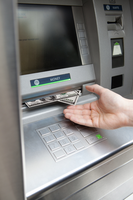








An automated teller machine or automatic teller machine, cash machine, cashpoint, cashline, or colloquially hole in the wall, is an electronic telecommunications device that enables the customers of a financial institution to perform financial transactions without the need for a human cashier, clerk or bank teller.
By the end of the 1960s, however, times were changing, and a broader segment of the population–more comfortable with the idea of self-service and more willing to trust unfamiliar technologies–was willing to give automated banking a try.
In 1967, a Scottish inventor named John Shepherd-Barron was sitting in the bathtub when he had a flash of genius: If vending machines could dispense chocolate bars, why couldn’t they dispense cash? Barclays, a London bank, loved the idea, and Shepherd-Barron’s first ATM was installed in a branch on Enfield High Street not long afterward. Unlike modern ATMs, Shepherd-Barron’s did not use plastic cards. Instead, it used paper vouchers printed with radioactive ink so that the machine could read them. The customer entered an identification code and took her cash–a maximum of £10 at a time.
The first automated banking machine in the U.S. was devised by a Dallas engineer and former professional baseball player named Donald Wetzel. Wetzel’s machine used plastic cards like the ones we use today. (Instead of radioactive ink, the cards stored account information in magnetic strips.) In September 1969, a Chemical Bank branch on Long Island installed the first of Wetzel’s machines.
By 1970, dozens of U.S. banks had jumped on the ATM bandwagon. To introduce this new machine to consumers, banks used all kinds of advertising tricks. For example, to get the attention of female customers, a bank in Columbus, Ohio, sponsored a six-hour Paul Newman movie marathon on a local television channel. Every 25 minutes during the movies, commercials for the bank touted the advantages of its new cash-dispensing machine.
However, it took a corporate gamble and a blizzard for the ATM to win the confidence of American consumers. In 1977, the chairman of Citibank took a huge risk, spending more than $100 million to install ATMs all over New York City. That investment paid off the following January when a huge blizzard hit New York, dumping 17 inches of snow on the city. Banks were closed for days; meanwhile, ATM use increased by 20 percent. Within days, Citibank had launched its by-now-familiar “The Citi Never Sleeps” ad campaign. Posters and billboards showed customers trudging through snow to get to Citibank ATMs.
After that, almost every one of the country’s banks followed Citi’s lead. The era of the ATM was underway.
ATMS TODAY
Today, there are almost 2 million ATMs around the globe. Although use of the machines has declined in recent years, likely because more people make purchases using credit and debit cards instead of cash, the ATM continues to have a place in modern culture. Today’s machines sell everything from airline tickets to movie tickets to medicine.